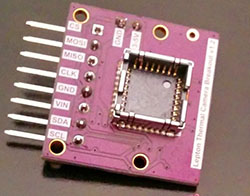Thermal imaging cameras are all the rage now, and one of the best IR cameras out there is Flir’s Lepton module. It’s the sensor in the FLIR ONE, a thermal imaging camera add-on for an iPhone. Somewhat surprisingly, Flir is allowing anyone to purchase this module, and that means a whole bunch of robotics and other various electronics projects. Here’s a breakout board for Flir’s Lepton.
Electron artisan [Mike] recently got his hands on a FLIR ONE, and doing what he does best, ripped the thing apart and built the world’s smallest thermal imaging camera. Compared to professional models, the resolution isn’t that great, but this module only costs about $250. Just try to find a higher resolution thermal imager that’s cheaper.
With this breakout board, you’ll obviously need a Lepton module. There’s a group buy going on right now, with each module costing just under $260.
The Lepton module is controlled over I2C, but the process of actually grabbing images happens over SPI. The images are a bit too large to be processed with all but the beefiest Arduinos, but if you’re thinking of making Predator vision with a Raspi, BeagleBone, or a larger ARM board, this is just the ticket.
You can check out some video made with the Lepton module below.
This is also project number 3000 on hackaday.io. That’s pretty cool and worthy of mention.

















I noticed on the groupget page the minimum is 100 instead of 1000, whats going on there? Very cool breakout board really opens up the possibility for some great projects.
Hey wattnotions, we are releasing Lepton in batches off 100 so that early adopters can get the Lepton and start developing and not wait for the 1000th customer.
Fair play to you for doing that!
Wish the price of the group buy is cheaper. At $260, it’s probably better to buy the finished product and rip the sensor apart and save the other parts for later use. Or repeat / retrace what Mike showed in his video.
We will be posting official FLIR interface documents soon so no protocol reverse engineering will be necessary.
The dreaded ‘soon’
I hear a copy is included with the half-life3 download!
no protocol reverse engineering IS necessary RIGHT NOW, Mike already did all the work.
http://en.wikipedia.org/wiki/Microbolometer
This one apparently uses vanadium oxide.
Anybody know about a coded aperture technique for increasing resolution? I have only stumbled over increasing frame rate so far.
This development is great, within a few years we will probably have a whole set of reasonable thermal imagining dyi kits and products for a few hundred usd to choose from. Such a big difference compared to 5 years ago. I have the ir-blue from the kickstarter, and while it does everything they said it would I would easily buy something similar with 64×64 or better and a little bit better temp. range (better range than the flir iphone thing with this sensor that is) for ~200 in the next few years, stand alone or for android, “kit” or ready made.
Pretty cool.
I did have a few ideas for increasing resolution such as using a spinning aperture prism made of IR transparent ZnSe to rotate the field of view slightly.
With some software this would sacrifice speed for resolution.
Also worth looking into is using an AOM, you can make these easily enough and a common material here is tellurium oxide (TeO2) available on ebay as powder but can be reconstituted into a crystal below about 740C if you have a kiln. (£16 or so)
The microwave annealer kits sold online will work if you are very careful and are good for a dozen or more pellets.
TeO2 is opaque at the wavelength these sensors work at, LWIR (9-14um).
An AOM requires a focused beam, so it likely won’t work here. The acoustic column is typically only a few hundred microns, so you’d be hard-pressed to make use it for scanning. The prism (or even a hot mirror – most likely cheaper than the prism) is probably a better idea.
unprotected? aluminium mirrors on piezo mirror tilters will work. I bought some off ebay only to find out that they were supposed to go into video projectors to increase the image resolution. They’re for very small angle deflection.
Who will be the first to show off stereoscopic thermal vision with Oculus VR?
That resolution on a VR display will probably be experienced as nightmarish, unless you overlay it on regular video like the iphone module does.
It reminds me of that old Degree commmercial where a cat burglar rolled said brand of deodorant all over his body to evade detection by thermal sensors. I can’t wait for all the tin-foil hat remedies against IR cameras. Should be a good show on youtube. :)
Tin foil is the perfect material actually I would say.
My dangerous idea was to discharge a CO2 fire extinguisher between two layers of overalls. Just add duct tape.
Why not use this
http://uk.farnell.com/jsp/search/displayproduct.jsp?SKU=2217999
2 x 50$ for shipping to germany – once for the module and once for the breakout board…….
could i just have more informations about the circuit and the programing code ?